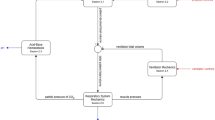Summary
A computer based evaluation system has been developed for the assessment of respiratory pressure flow dynamics, pulmonary gas exchange and ventilation perfusion interrelationships. This system is based on the acquisition of primary data on-line from intubated and ventilated patients consisting of airway pressures, ventilatory flows and mass spectrometric quantification of inspired and expired gas concentrations. The system has been applied to the study of patients with the adult respiratory distress syndrome (ARDS) following trauma and/or sepsis. The programs developed for evaluation of these data permit an interactive graphic capability to be used by the physician or the respiratory technician in a specific patient to determine the nature of the abnormalities in respiratory function. By use of this system for quantification of the extent and complications of the ARDS condition the specific ventilatory or cardiodynamic therapy can be tailored to meet the patient's physiologic needs. Techniques for optimization of conventional ventilator therapy are described and its application to the specific instances of combined high frequency ventilation or differential lung ventilation are presented. The clinical experience with this unit in a major trauma center suggests that quantitative analysis of an individual patients' respiratory dysfunction permits a precise, accurate and more effective approach to determining corrective therapy in ARDS.
Similar content being viewed by others
Bibliography
Baehrendtz S: Differential ventilation and selected positive end-expiratory pressure. Opuscala Medica Suppl 61, 1983.
Berggren SM: The oxygen deficit of arterial blood caused by nonventilating parts of the lung. Acta Physiol Scand Suppl 11, 1942.
Bindsler L, Santesaon J, Hedenstierna G: Distribution of inspired gas to each lung in anaesthetized human subjects. Acta Anaesthiol Scand 25: 297–302, 1981.
Geisler FH, Farrell EJ, Siegel JH: A new non-invasive method for the simultaneous determination of cardiac output,\(\dot V_A /\dot Q_c^\prime \) disparity, and the magnitude of peripheral perfusion, suitable for use in the critically ill patient. J Trauma 18: 751–765, 1978.
Geisler FH, Siegel JH: Clinical evaluation of a non-invasive inert gas washout method to quantify cardiopulmonary abnormalities in critically ill patients. IEEE 80 CH 1570-1, Computer applications in medical care, vol. III. 1980, pp 1581–1589.
Haldane JS: Respiration. Yale University Press, New Haven, 1922.
Ingelstedt S, Jonson B, Nordstrom L, Olsson S-G: A servocontrolled ventilator measuring expired minute volume, airway flow and pressure. Acta Anaesthesiol Scand (Suppl) 47: 7–27, 1972.
Janson CM, Brimm JE, Peters RM: Instrumentation and automation of an ICU respiratory testing system. In: Nair S (ed) Computers in critical care and pulmonary medicine. Plenum Publishing Corporation, New York, 1980, pp 51–58.
Nordstrom L: Hemodynamic effects of intermittent positive-pressure ventilation with and without an end-inspiratory pause. Acta Anaesthesiol Scand (Suppl) 47: 29–56, 1972.
Osborn JJ: Monitoring respiratory function. Crit Care Med 2: 217–220, 1974.
Osborn JJ, Beaumont JO, Raison JCA, Russell J, and Gerbode F: Measurement and monitoring of acutely ill patients by digital computer. Surgery 64: 1057–1070, 1968.
Peters RM, Brimm JE, Janson CM: Clinical basis and use of an automated ICU testing system. In: Nair S (ed) Computers in critical care and pulmonary medicine. Plenum Publishing Corporation, New York, 1980, pp 173–188.
Peters RM, Hilberman M, Hogan JS, and Crawford DA: Objective indications for respirator therapy in post-trauma and post-operative patients. Am J Surg 124: 262–269, 1972.
Prakash O, Jonson B, Meij SH, van der Borden SG, Hogenholtz PG: Computerized monitoring of lung and heart function in the operating room: A description of ‘methodological platform’. In: Nair S (ed) Computers in critical care and pulmonary medicine. Plenum Publishing Corporation, New York, 1980, pp 129–148.
Riley RL, Cournand A: ‘Ideal’ alveolar air and the analysis of ventilation-perfusion relationships in the lungs. J Appl Physiol 1: 825–847, 1949.
Severinghaus JW: Simple, accurate equations for human blood O2 dissociation computations. J Appl Physiol 46: 599–602, 1979.
Sjostrand U: High-frequency positive-pressure ventilation (HFPPV): A review. Crit Care Med 8: 345–364, 1980.
Soo Hoo SL, Koerner SK, Brown HV: A comprehensive pulmonary data processing system. In: Nair S (ed) Computers in critical care and pulmonary medicine. Plenum Publishing Corporation, New York, 1980, pp 311–328.
Author information
Authors and Affiliations
Rights and permissions
About this article
Cite this article
Siegel, J.H., Stoklosa, J., Geisler, F.H. et al. Computer-based evaluation of cardiopulmonary function for the optimization of ventilatory therapy in the adult respiratory distress syndrome. International Journal of Clinical Monitoring and Computing 1, 107–126 (1984). https://doi.org/10.1007/BF01872749
Received:
Accepted:
Issue Date:
DOI: https://doi.org/10.1007/BF01872749




